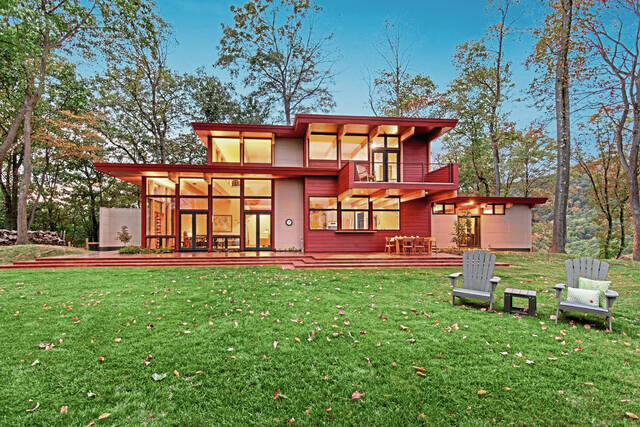https://mirror.triblive.com/local/regional/seattle-homebuilder-offers-home-kits-based-on-frank-lloyd-wrights-architectural-principles/
Seattle homebuilder offers home kits based on Frank Lloyd Wright's architectural principles

For the right price, you can stay in one of several homes designed by Frank Lloyd Wright, situated in Mt. Pleasant Township’s Polymath Park.
But if you are so inclined, you could also have a similar design of your very own.
Seattle-based Lindal Cedar Homes offers a line of Wright-inspired house designs, many of which were created by Wisconsin custom home designer Aris Georges, a former student and teacher at the Frank Lloyd Wright School of Architecture in Arizona.
Lindal approached the school in 2009, Georges said, looking to develop a portfolio of designs as part of its Architects Collaborative program. Georges was one of five faculty who contributed designs and he later provided digital 3D models and renderings of new designs. In 2015, he was asked to develop a “Designer Series” portfolio of homes, which led to work on custom homes that incorporate the sharp angles and highly geometric design familiar in much of Wright’s architecture.
The home kits are delivered by truck, and their price does not include construction and labor costs, nor the cost of the house’s foundation and utility infrastructure. Lindal does not list set prices on its website because most of the designs are open to heavy customization.
There are nine home kits in Lindal’s Imagine Series. All draw heavily on Wright’s Usonian home designs, which offer a wide range of flexibility and customization. Lindal also offers a handful of other options inspired by his work.
“I’ve grown to appreciate the notion of ‘remix’ or ‘cover’ design and architecture,” Georges said. “These projects for the Lindal Imagine Series are timid steps in that direction.”
Georges, 59, spoke with TribLive about being inspired by the renowned architect. This interview has been edited for length.
Q: As a former student and teacher at the Wright school of architecture, what are some of the ways you evoke his design philosophy without simply copying it?
A: The disciplined use of geometry and grids is at the core of the Usonian system. Wright called the compositions of the designs using these tools as being similar to the warp and weft of weaving. However, it is important to focus on generating intriguing spatial relationships that are eventually expressed on the physical elements of the building, He called that approach, “designing from within, outwards.” Of course, nature was the ultimate source for inspiration in Wright’s organic architecture philosophy and the emulation of nature through geometry is an endless resource for designs that belong in their surroundings and offer beautiful, well-proportioned, well-lit, functional spaces for human life.
Q: What is the biggest challenge in creating a home that utilizes Wright’s design style?
A: The challenge is keeping the scale and proportion related to both the human scale and the qualities of the landscape and surroundings. For Wright, all elements of a building, tangible and intangible alike, are interconnected through what he called “tenuity.” Spaces are continuous transitions, sometimes contained in cozy solid masses, others released in long views through repeated fenestration, but never are the spaces “boxes” that trap spatial flow and limit the human experience by “containing it.”
Q: What do you enjoy most about working on these Wright-inspired home kits?
A: (Clients and architects both) bring something to the table, and together we refine it. I thrive on accessible visualization of the design, 3D digital walkthroughs and realistic depictions of light and textures that help clients begin to live in their homes way before they are built. Having a chest of anecdotes about Frank Lloyd Wright, from my years of living/studying and working at the two Taliesins (in Arizona and Wisconsin), also brings a layer of vigor and storytelling that balances the rigorous design process.
Copyright ©2025— Trib Total Media, LLC (TribLIVE.com)
